#americanrevolution
Photo

James Armistead Lafayette
James Armistead Lafayette (l. c. 1748-1832) was an African American Patriot who served the Continental Army as a spy during the American Revolutionary War (1775-1783). During the Siege of Yorktown, he infiltrated the British camp to bring crucial intelligence to the Americans. After the war, he was freed from slavery with the help of the Marquis de Lafayette, whose name he adopted.
Continue reading...
127 notes
·
View notes
Text
(amrev) Book pile got a new addition today AYYY
(thx Hannah :33)


#nerd stuff#amrev#american revolution#baron von steuben#von steuben#queer history#lgbtq history#ofc im using that tag for him teehee#books#booktok#history#history nerd#americanrevolution#american revolutionary war#continental army#friedrich wilhem von steuben#mount vernon#18th century#freiherr von steuben#pls tell me thats a tag smh#yeah uh#idk how tags work#and#idk what else to tag#bc#idk what ik doing#TEEHEE
30 notes
·
View notes
Photo

SOUL OF LEAD

In death, a tradition is born.
#1776#americanrevolution#drama#fiction#hamilton-era#historical#juliet#lies#revolutonarywar#romance#romeo#shakespeare#shakespeare-adaptation#historical-fiction#books#and we are done
9 notes
·
View notes
Text

Coming Soon from Rocky Mountain Minifigs. Printed on original LEGO pieces and including original LEGO accessories (when they exist!)
#lego#custom#minifigs#revolutionary#war#revolutionarywar#americanrevolution#american#british#french#1700s
4 notes
·
View notes
Text

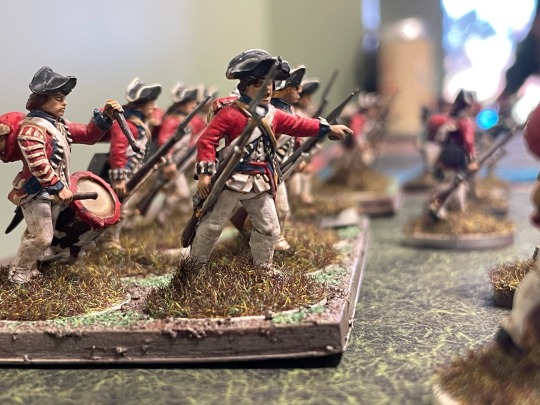


In a departure from World War II, these are soldiers of the 80th Regiment, Royal Edinburgh Volunteers, as they would have looked during the American War of Independence. These lowland Scottish troops were recruited into service for the British Army in January of 1778, and after a year of training, set out across the Atlantic to reinforce the beleaguered General Henry Clinton in New York. After suffering a break out of Typhus, the flank companies (light infantry and grenadiers) joined Clinton in the Siege of Charleston, SC in 1780. The entire regiment would be featured heavily in the Virginia Campaign of 1781, and was eventually captured at the Siege of Yorktown in October. As POWs, these men traveled through the Virginia Piedmont on their way to prison camps in Winchester, VA.
#americanrevolution#miniatures#history#king george iii#british army#george washington#virginia history#american history#military history#historic miniatures#1776#declaration of independence
2 notes
·
View notes
Photo
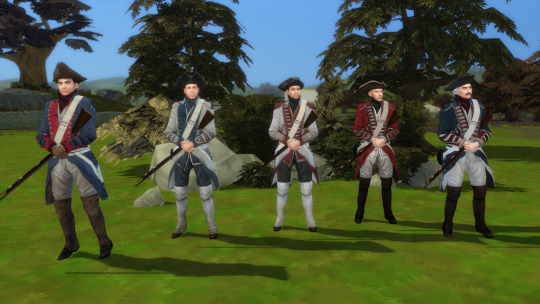

Revolution Sims AC3 18th Soldier Century Uniform Recolours for the Sims 4.
New swatch national uniforms include - USA - FRANCE - SPAIN - BRITAIN - PRUSSIA
Original Meshes by @revolution-sims - Needs no foot mod found on @revolution-sims page. Full credit to this creator for converting the AC3 mesh to TS4.
https://simfileshare.net/folder/171761/
#revolutionsims#sims4 AssassinscreedSims4 SimsConversion Sims4CC#sims4cc#sims 4 clothes cc#americanrevolution#18thcentury#assassinscreed#sims4#thesims4
34 notes
·
View notes
Quote
In a break with previous policy, the British responded to the Boston Tea Party with repression rather than accommodation. It was not the mob action that prompted this reaction. Before the advent of democracy, rulers on both sides of the Atlantic considered crowd action a legitimate way to register popular discontent. In recent memory, Boston mobs had protested imperial measures by sacking the lieutenant governor’s mansion, fighting off customs officers and assaulting army sentries. In each case, the government had hardly batted an eyelid. This time, however, there was colossal destruction of private property leading to a growing realisation that unless imperial authority was restored, control over the colonies might altogether slip away. ‘We must risk something’, Lord North said. ‘If we do not, all is over.’ In swift succession, Parliament closed and blockaded the port of Boston, dissolved the Massachusetts charter and made colonial officers the appointees of the governor rather than the assembly, allowed for criminal trials to be moved out of the colony, and provided for the bypassing of colonial assemblies when quartering imperial troops. In a parallel move, troops descended on Boston.
The 50 Years that Made America
5 notes
·
View notes
Text
#history#Twitterstorians#Britishhistory#Americanhistory#politics#Georgians#SouthCarolina#WarforIndependence#AmericanRevolution#Loyalists#Patriots#Whigs#Tories#Charles II#James II#George III#Glorious Revolution
3 notes
·
View notes
Photo

Did I mention that I'm in a show in Philly just in time for the fourth of July. It's a good time to remember how this country came to be and who was there. Come celebrate the beginning of the nation with us an SE what fun things we can do on a 3"x7' platform three feet off the ground 🥰 🔗Tix in my bio Also would anyone like to take my new headshots? These are ten years old 😹 #Repost ///@amrevtheshow: Say hello to Kiersten M. Adams! Kiersten (@purplekittylife) is part of the talented cast of "The American Revolution” A Philly native, Kiersten is a flow artist currently working all over the Philadelphia area. She is a trained musical theatre actress who has been found most recently in Alterra Production's run of "Midnight" as well as their online interactive series "Thickett." She is passionate about movement as a form of expression and enjoys teaching and being a mom. See Kiersten and the rest of the cast this week! Get your tickets at the link in our bio. #amrevtheshow #actor #amrev #americanrevolution #physicaltheater #history #historicaltheater #comedictheater #comedy #philly #visitphilly #historicphiladelphia #oldcity https://www.instagram.com/p/CfZOAzCLEm0/?igshid=NGJjMDIxMWI=
#repost#amrevtheshow#actor#amrev#americanrevolution#physicaltheater#history#historicaltheater#comedictheater#comedy#philly#visitphilly#historicphiladelphia#oldcity
4 notes
·
View notes
Text
"Many people die at twenty five and aren't buried until they are seventy five."
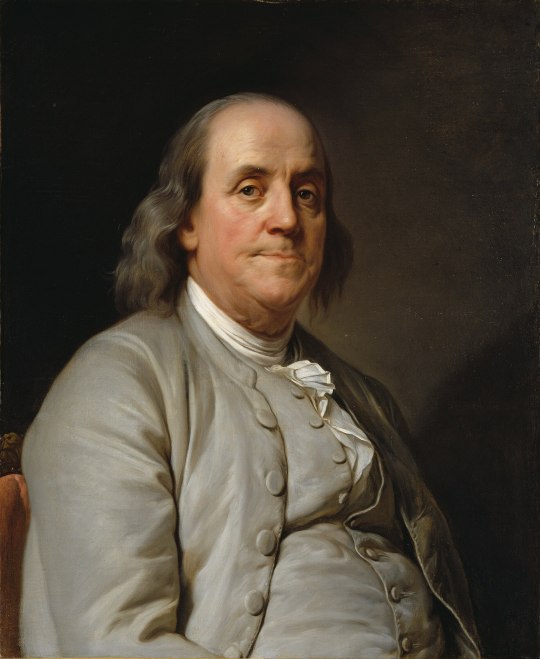
Benjamin Franklin was an American polymath, a leading writer, scientist, inventor, statesman, diplomat, printer, publisher, and political philosopher.
Born: 17 January 1706, Milk Street, Boston, Massachusetts, United States
Died: 17 April 1790 (age 84 years), Philadelphia, Pennsylvania, United States.
Founding Father and Polymath: Benjamin Franklin (1706-1790) was one of the Founding Fathers of the United States, playing a crucial role in drafting the U.S. Constitution. He was a polymath, excelling in various fields such as science, writing, and politics.
Inventor of the Lightning Rod: Franklin is credited with inventing the lightning rod in 1752. His experiments with electricity led him to propose the use of a grounded rod to protect buildings from lightning strikes. This invention significantly improved the safety of structures during storms.
Author and Printer: Franklin was a prolific writer and printer. His famous publications include "Poor Richard's Almanack," known for its witty and practical aphorisms. He also owned and operated a successful printing business in Philadelphia.
Diplomat and Statesman: Franklin was a skilled diplomat and played a vital role in securing French support during the American Revolution. He negotiated the Treaty of Alliance with France in 1778, which proved crucial to the American victory over the British.
Founder of the First Public Library: Franklin was a strong advocate for education and founded the Library Company of Philadelphia in 1731, the first subscription library in the American colonies. This institution aimed to provide access to books and promote knowledge among the public.
#FoundingFather#Polymath#Inventor#LightningRod#ElectricityExperiments#PoorRichardsAlmanack#Printer#PrintingBusiness#Diplomat#Statesman#AmericanRevolution#TreatyofAlliance#FrenchSupport#LibraryCompanyofPhiladelphia#EducationAdvocate#Author#Scientist#Philosopher#PoliticalLeader#Philadelphian#quoteoftheday#today on tumblr
0 notes
Text
⭐ (FRIDAY TALE) 𝑻𝒉𝒆 𝒔𝒂𝒄𝒓𝒆𝒅 𝒅𝒆𝒆𝒓 𝒘𝒊𝒕𝒉𝒐𝒖𝒕 𝒂 𝒇𝒂𝒄𝒆

In the shrouded year of 1777, John, aforetime a humble tiller of soil on the village's outskirts, found himself pressed into service, a soldier patrolling the untamed expanses of the American colonies. John, knowledgeable yet far from witless, threw his lot in with the troops arriving not to the idyllic European dream but to a sprawling, uncharted realm veiled in ominous forests, each step fraught with peril. Bears, wolves, and mountain lions skulked, and savage Indians, elusive as shadows, posed the gravest threat around every bend. Amid the woodlands lay remnants of tortured souls, their corpses baring the cruel traces of knives, tortures, and scalping. Adding to the complexity, the colonists nursed a fervent desire for war against the King. A ragtag assemblage of rough-hewn farmers, unlettered lawyers, and rogue merchants masqueraded as an army opposing His Majesty's forces.
The following day, John's contingent hastened to the front lines, a perilous journey through the blood-soaked forest. Resting among the trees, John, compelled by nature's call, relieved himself near the company. In doing so, he glimpsed a majestic, antlered deer, a bounty ample for three days. With rifle in hand, he pursued the creature, firing a shot that sent it fleeing. Yet, upon turning, he found only trees, the forest's embrace closing in, and he lost himself! Night descended, and beneath a tree, he slept, resuming his futile search at dawn.
After weeks of wandering the forest alone, hungry, and armed with a lone shot, John's plight became unbearable. He shouted, knelt in despair, shot his final round, and cursed the day he enlisted. Weary and beaten, the splendid deer reappeared, its form radiant and faceless. Emitting guttural, almost human sounds, it declared, "You came to control, but none can command these lands. Neither you, clad in red, nor the indigenous people who've dwelled here for generations. Nor those who follow. America shall know no master. This land is both blessed and cursed by its freedom. Now, sleep."
And in an unnamed forest, the British soldier met his silent demise, abandoned in an alien far wild land called America…
1 note
·
View note
Photo
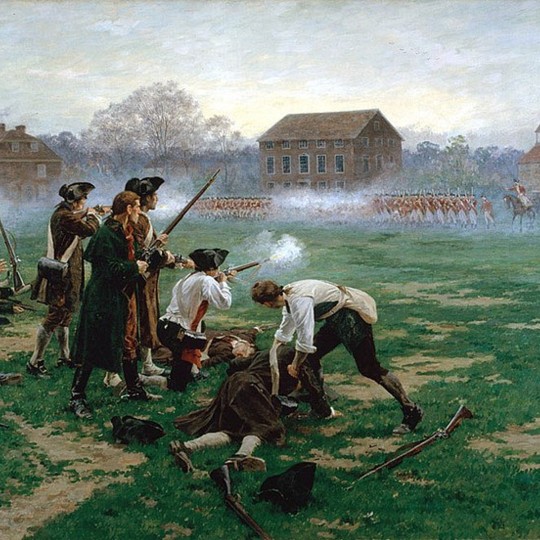
Battles of Lexington and Concord
The Battles of Lexington and Concord were engagements fought between British regular soldiers and militia from the colony of Massachusetts on 19 April 1775. The British troops were on their way to seize military supplies stored in the town of Concord when they were confronted by the colonial militiamen. An American victory, the battles triggered the American Revolutionary War (1775-1783).
Continue reading...
110 notes
·
View notes
Text
Every now again I just randomly upgrade my art style by 100.
So, uh, appreciate Von Steuben, but drawn well.
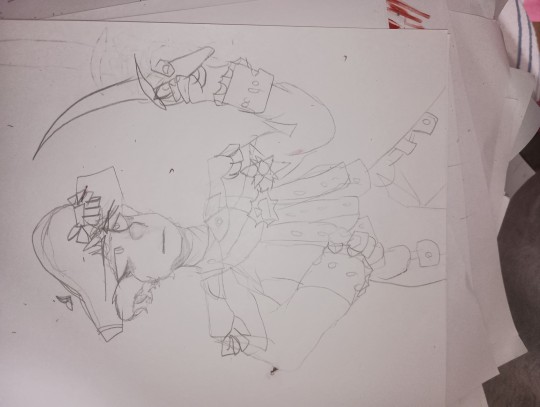
Low quality picture, but you get the point.
I swear it looks nicer in person, I'll upload a good pic LATER❤️❤️❤️❤️
We love procrastinating around here. That's why I'm failing math.
#amrev#amrev fandom#american revolution#baron von steuben#idk#queer history#von steuben#amrev art#artists on tumblr#artwork#art#guys hes actually my husband fr fr no cap#my artwork#my art#americanrevolution#bicorne#is that even a tag?#why#art improvement#update#im tryin my best#this is my sad attempt to grow my account#hobby#lgbtq history#history#friedrich wilhem von steuben#Steubenussy#im using that tag every time now#death stare#awoop jumpscare
5 notes
·
View notes
Text
Thinking about the Sullivan Expedition
By Jonathan Monfiletto

During its reign over its North American territory, Great Britain attempted to keep peace with the Native Americans who already lived here. Following the French and Indian War, as the North American theater of the Seven Years’ War was known, the British government adopted the Proclamation of 1763 to declare its colonists could not settle west of the Appalachian Mountains.
The western portion of British-claimed territory was considered to be Native American land. In New York, the boundary between the colony and indigenous land lay around the modern-day Utica-Rome area. After the American Revolution, however, the proclamation was nullified and the newly ordained American citizens began to explore and settle their new country.
That brought the Public Universal Friend – the person – and the Society of Universal Friends – the group – into what they called the Genesee Country, as the first permanent, non-native settlers of what is now Yates County. It also brought Levi Benton and his family – the first settlers of the county aside from the Friends – and many other Pennsylvanians and New England Yankees to the area.
The Genesee Country became a focal point for white settlement in the early years of the American nation. That’s because of an event that happened a decade before the Friends arrived, in which soldiers who took part returned home with stories of a wonderful and bountiful land.
In 1779, General George Washington dispatched General John Sullivan and his forces to march up the Susquehanna River in eastern Pennsylvania to the Genesee River in western New York. The goal was to harass the tribes of the Iroquois Confederacy who lived in that area and had allied with the British.
What became known as the Sullivan Expedition occurred after what the Continental Army considered massacres by Iroquois warriors in Wyoming Valley (along the Susquehanna in Pennsylvania) and Cherry Valley (south of the Mohawk River in New York). In secondary accounts of the expedition, these events read more like raids in which Iroquois forces took part alongside, and under the direction of, British forces. The Continental Army nevertheless decided it needed to specifically target the Iroquois with an offensive in response.
The expedition did not result in a large loss of life – there were a few casualties on both sides in scattered skirmishes – as thousands of Iroquois fled their villages toward British strongholds ahead of the approaching troops. The Army did not take any Iroquois captives, though that had been a goal of the expedition, and the main result was troops destroyed Iroquois villages and decimated homes and crops.
In 1929, during the 150th anniversary of the Sullivan Expedition, Herbert D. Winters – the head of the history department of Keuka College – wrote a series of 11 articles for The Chronicle-Express that offered a detailed and extensive history of the expedition. He discusses the planning of the expedition and its beginnings and then charts Sullivan’s course. I used Winters’ writings – along with an essay by Seneca County Historian Walter J. Gable, a webpage from the National Park Service, and the Historical Marker Database website – to inform this article.
Following the course of the Susquehanna, Sullivan and his forces staged the Battle of Newtown – in present-day Elmira – against, again, a mix of British and Iroquois forces. From there, the expedition entered the Finger Lakes region through Catherine’s Town at the southern end of Seneca Lake. The expedition marched northward up the east side of Seneca Lake.
Once Sullivan’s forces reached the northern end of Seneca Lake, at the Seneca village of Kanadesaga, he sent detachments down both the west side and east side of Cayuga Lake. Though the expedition did not travel the entire length of the west side of Seneca Lake, it did reach present-day Yates County. A detachment was sent to the Seneca village of Kashong to destroy it.
As Winters documents, a force of 400 men, and later an additional 200 reinforcements, went to work destroying the crops they found there – potatoes, apples, peaches, cucumbers, watermelons, and corn. The village, like many the expedition encountered, was already deserted of people. This force joined up with the main body to continue to the Genesee River, but upon their return eastward they visited Kashong once again to inflict further destruction on the houses and buildings there.
The sesquicentennial celebration in 1929 saw the establishment of numerous monuments to the Sullivan Expedition. These consist largely of stone-and-metal monuments depicting the route of Sullivan’s forces and standard blue-and-yellow markers recalling where Iroquois villages once stood and other aspects of the expedition. There are at least 10 such monuments in Seneca County alone, with four in Cayuga County, three in Ontario County, and one each in Schuyler County and Tompkins County.
According to HMDB, there are a total of 72 historical markers dedicated to the Sullivan Expedition; other markers are located elsewhere throughout New York and Pennsylvania, along the route Sullivan traveled. There are none in Yates County that I am aware of, although one of the monuments listed in Ontario County is located at Kashong, a hamlet on the border of Ontario and Yates counties.
The markers denoting the trail of the Sullivan Expedition refer to it as a campaign “against the hostile Indian nations” that resulted in “extending westward the dominion of the United States.” A stone obelisk in Waterloo even states it is meant “to commemorate the destruction of the Indian village Skoi-Yase.” We should certainly commemorate the Sullivan Expedition, but how to commemorate it without such harmful language is a difficult question.
The Sullivan Expedition has been celebrated in the Finger Lakes region for clearing the way, figuratively and literally, to settlement of the land after the war. On the one hand, the expedition was indeed a military campaign against an enemy during wartime. On the other hand, it was a genocide, as the Continental Army sought not just to attack the Iroquois but to wipe them and their livelihood from their land. I’m wondering how we should discuss the Sullivan Expedition and place it in historical context.
The Sullivan Expedition resulted in the settlement of the Finger Lakes region, and people of white European descent would not be here without it. Yet, such a tragic and horrific event probably should not be celebrated the way it is on so many historical markers around the region.

#historyblog#history#museum#archives#american history#us history#local history#newyork#yatescounty#fingerlakes#geneseecountry#geneseeriver#senecalake#cayugalake#sullivanexpedition#revolutionarywar#americanrevolution#nativeamericans#native american history#kashong
0 notes
Text

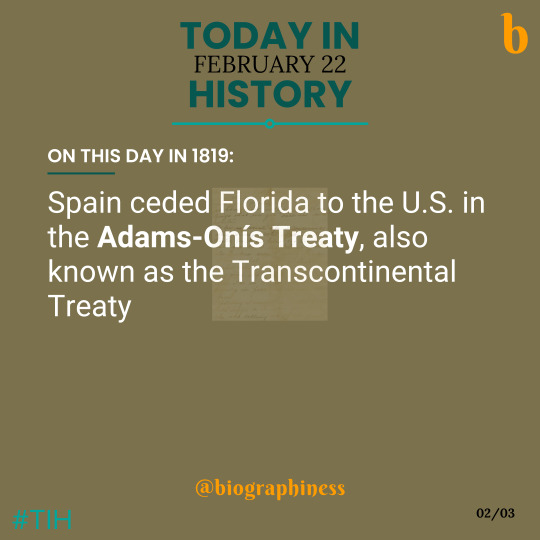
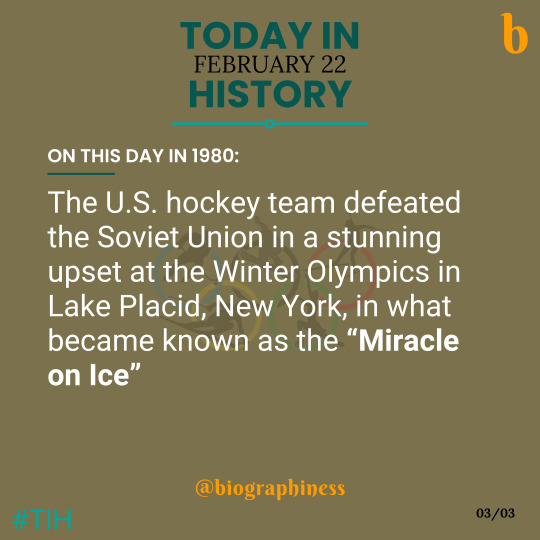
On this day on February 22 in history, George Washington was born, Spain ceded Florida to the U.S., and the U.S. hockey team defeated the Soviet Union in a stunning upset.
Follow for more👉 @biographiness
#Biographiness#Biograghines#TodayInHistory#TIH#onthisday#OTD#HistoryEvents#DailyHistory#HistoryFacts#February22#HistoryMatters#GeorgeWashington#AmericanRevolution#AdamsOnisTreaty#Florida#MiracleOnIce#Hockey#WinterOlympics
1 note
·
View note
Text
The British East India Company

The British East India Company was one of the first corporations to exist in history. It has a founding place in how we should examine the role of corporations. These multi-national private entities operating for profit under the benevolent watch of their state continue to cast long shadows today. In the case of the East India Company their influence over the British monarchy, George III, during his reign was one of the determining causes of the American Revolution in 1765. In addition, it was this corporation that spurred the colonial takeover and exploitation of the Indian subcontinent. Corporations have much more narrow profit driven intentions than states.
“The EIC was the means by which Britain conducted its imperialistic policies in Asia, and it made millions through its global trade in spices, tea, textiles, and opium. It was criticised for its monopolies, harsh trading terms, corruption, and the damage it did to the wool trade. Finally but by no means least, the EIC swept away rulers that stood in its path, relentlessly siphoned off resources, and repressed the cultural practices of the peoples living within its vast territories. In short, the EIC was the "sharp end of the British imperial stick" (Faught, 6). The EIC's directors and its shareholders gained immense riches. India, in contrast, became ever-poorer. Much more than a trading company, the EIC ultimately became a state within a state, even an empire within an empire, and one accountable to no one except its shareholders.”
- (https://www.worldhistory.org/East_India_Company/)

Corporate Slaver In The Transatlantic African Slave Market
The East India Company was a slaver. It used slave labour and trafficked in slaves for profit. Not the biggest player in the transatlantic slave market it transported African slaves to its holdings in India and Indonesia. The Royal African Company was the major slaver corporation operating at that time. It is important to remember just how crucial this global trade was to Britain in the 17C and 18C. Foundational wealth necessary for the forthcoming industrial revolution was established via profits from slavery.
“There are several implications - first is evidence of the British East Indian Company participation in trading slaves. Second, records from St Helena, an island in South Carolina is proof the company transported slaves to the Americas.”
- (https://aquila.usm.edu/cgi/viewcontent.cgi?article=1153&context=slisconnecting#:~:text=Thereareseveralimplicationsfirst,transportedslavestotheAmericas.)

Elephants at Sezincote House by Des Blenkinsopp is licensed under CC-BY-SA 2.0
The Armed Forces Of The British East India Company
The British East India Company had its own army, controlling some 200, 000 soldiers or mercenaries. This number was double that of the actual British army at that time. The East India Company via its military force subdued the Indian principalities and states it had begun trading with. It applied ruinous taxation upon the residents of these territories and carried out what can only be described as sanctioned looting. India had been the dominant textile exporter globally up until this time and the East India Company pillaged and exploited economically this to their extreme advantage. This would eventually result in the 1857 Indian Uprising, where Indian soldiers in the British army mutinied against their British officers. The push for Indian independence would grow out of the disgraceful treatment of Indians by the corporation and the British colonial state. Talk about taxation without representation!

Photo by Sawyer Sutton on Pexels.com
Taxation Without Representation
The American Revolution was driven by concerns like taxation of the colonies without parliamentary representation. The East India Company was behind many of the British state moves to raise more money by taxing the American colonists. The Stamp Act, the Townshend Acts, and the Tea Act all sought to raise more money from the colonists and were greatly unappreciated by the Americans.
“22 March 1765 the British Parliament passed the Stamp Act, which sought to raise money to pay for this army through a tax on all legal and official papers and publications circulating in the colonies.”
- (https://www.parliament.uk/about/living-heritage/evolutionofparliament/legislativescrutiny/parliament-and-empire/parliament-and-the-american-colonies-before-1765/the-stamp-act-and-the-american-colonies-1763-67/)

Photo by SevenStorm JUHASZIMRUS on Pexels.com
Corporate greed can be said to be at the heart of Britain’s treatment of India and the American colonies. Short sighted, profit driven policies which in the end cost Britain hugely in terms of losing its colonies, which would prove to become immensely wealthy over the following centuries. World power would shift from Britain to America on the back of these resource rich lands.
“there were still accusations that EIC officials were enriching themselves at the expense of the interests of the British state – even Clive came under suspicion. The EIC officials who retired to England and an extravagant retirement with their riches were known disparagingly as 'Nabobs', a corruption of the Mughal title for a high-ranking official, nawab.”
- (Mark Cartwright, Sept 2022)

'My hero was good at hanging' from Scenes from the Private and Public Life of Animals by J. J. Grandville is licensed under CC-CC0 1.0
It is the age old battle between private wealth and public good. Corporations are predominantly on the side of the former, with their principals stashing away as much private loot as possible. Tories and conservative governments more generally are invariably peopled with those closely tied to corporations. Slashing the public service and privatising it are practices still widely pursued today. The neoliberal economic thinking and their largely discredited ‘trickledown effect’ BS has been hugely popular over the last several decades. This is why we now have the greatest economic divide between the small group of the super wealthy and the rapidly expanding working poor. The rise of mega corporations with oligopoly powers in highly concentrated markets has seen price setting and corporate price gouging during recent high inflationary periods around the globe. The rentier economies are all about endless fees, fines, and charges being applied to every aspect of living in the ‘user pays’ environment so favoured by these multinational corporations. The British East India Company would be totally at home in this modern corporate world. Indeed, large corporate armies are on their way back as we observed in Iraq and Afghanistan quite recently.
Robert Sudha Hamilton is the author of Money Matters: Navigating Credit, Debt, and Financial Freedom.
©HouseTherapy
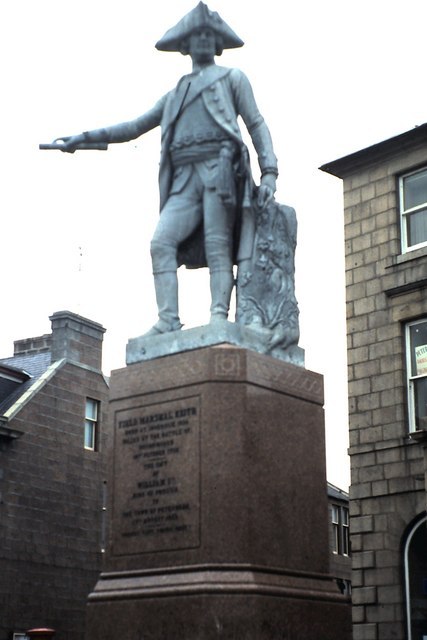
Statue of Field -Marshal James Keith by ronnie leask is licensed under CC-BY-SA 2.0
Read the full article
#Americanrevolution#British#corporategreed#corporations#EastIndiaCompany#history#India#multinationals#StampAct#Taxes#TeaAct
0 notes